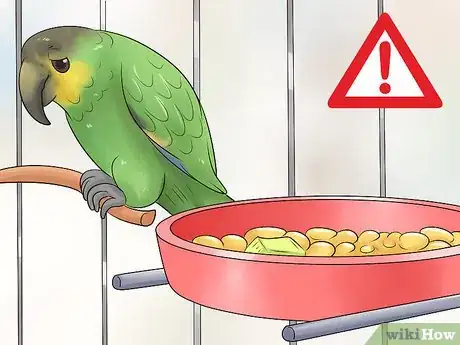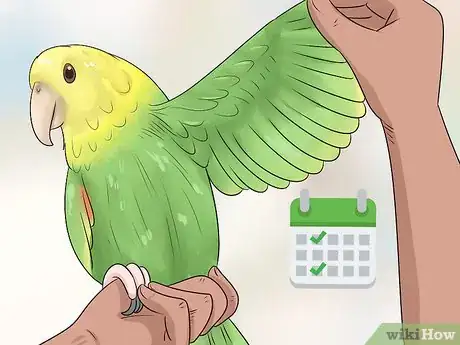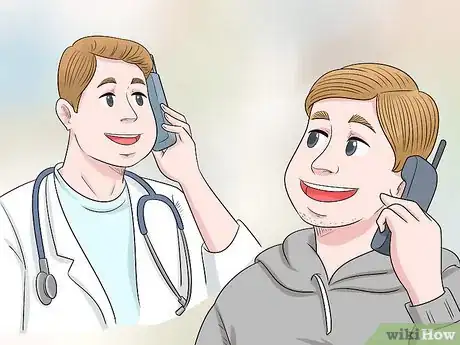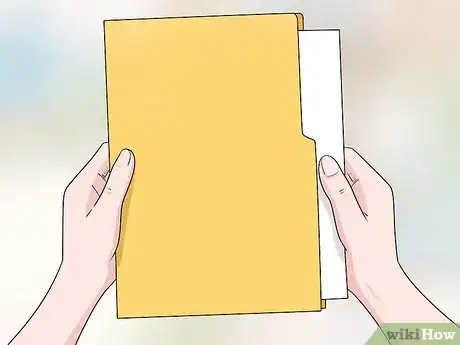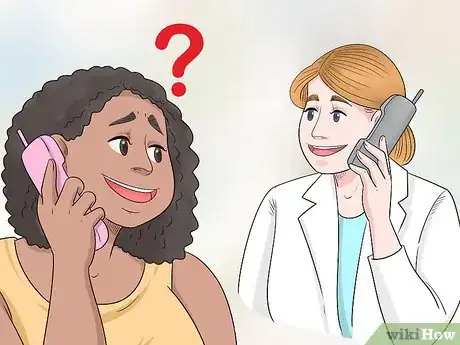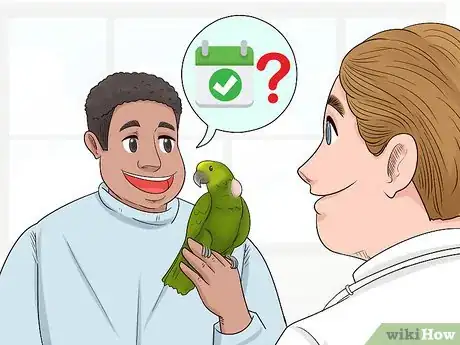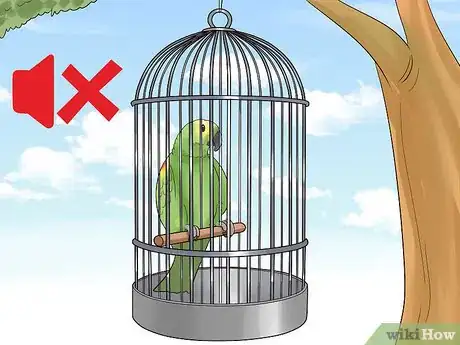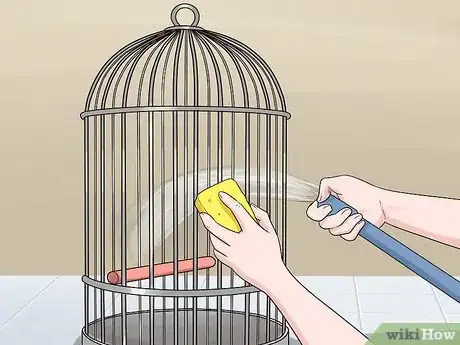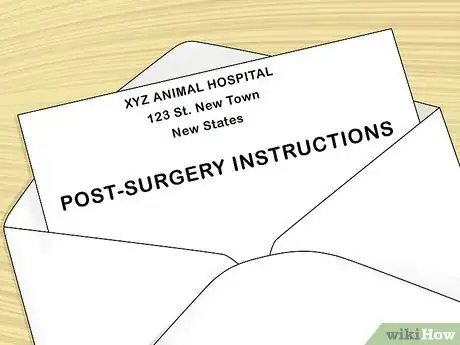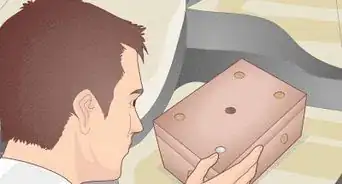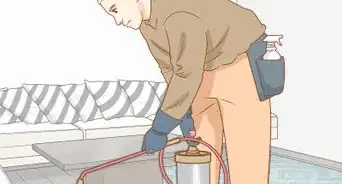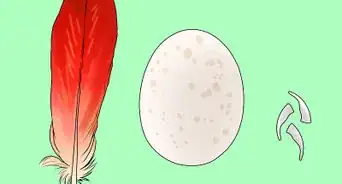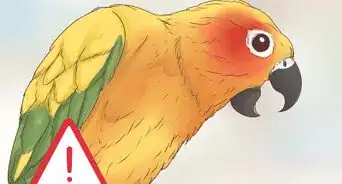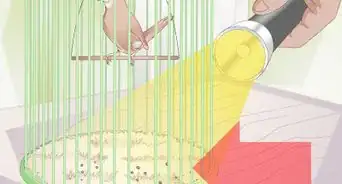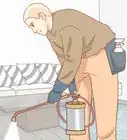This article was co-authored by Pippa Elliott, MRCVS. Dr. Elliott, BVMS, MRCVS is a veterinarian with over 30 years of experience in veterinary surgery and companion animal practice. She graduated from the University of Glasgow in 1987 with a degree in veterinary medicine and surgery. She has worked at the same animal clinic in her hometown for over 20 years.
This article has been viewed 20,604 times.
Amazon parrots are beautiful birds that make wonderful companions, but, like any pet, they can get sick. Unfortunately, Amazon parrots are prone to tumors, which are a sign of cancer. However, you can learn how to identify a tumor and how to help your feathered friend recover. Always consult your veterinarian immediately if you see anything that might look like a tumor.
Steps
Identifying a Tumor
-
1Learn about malignant and benign tumors. Tumors can be on the skin or inside the body. Tumors on the outside of the parrot may look like a lump, but can be soft or hard in texture. There are 2 main kinds of tumors, malignant and benign, and both kinds are cancerous.
- Malignant tumors are more likely to spread and end the life of the bird.
- Though benign tumors aren’t as likely to spread, they can grow very large and obstruct the parrot’s movements or break open and cause an infection.
-
2Recognize common forms of tumors in Amazon parrots. All lumps or tumors, regardless of size location, should be checked out by a veterinarian. Amazon parrots are especially prone to a few specific kinds of tumors.[1]
- Lipomas are benign tumors and can be found anywhere on the body. They are most common in obese parrots. They can be found inside and outside the body, and often just look like lumps.
- Fibromas are also benign and usually appear on the wing. It’s important to talk to your vet immediately if you see a lump on your parrot’s wing--if you wait too long, the wing might have to be amputated.
- Squamous cell carcinomas are malignant skin tumors. They’re especially common around the tip of the wing, the toes, and the face. They look similar to moles.
- Internal tumors can be difficult or impossible to detect without a vet. They can appear anywhere inside the body and can be malignant or benign. They may look like regular swelling or bloating.
- Abscesses are not tumors, but it can be impossible to tell the difference between them without testing.
Advertisement -
3Check for any unusual behavior. Some tumors appear inside the body, so you may not notice any lumps. Your bird’s behavior might be your only warning. Keep a close watch on your bird and talk to your vet if you see any unusual activity.[2]
- A bird who refuses to use a leg or wing may have a tumor in it.
- Lack of appetite is a common warning sign that the bird is sick, and one possible explanation is a tumor.
- If your bird changes its activity level drastically, bring it to the vet.
-
4Check your bird for lumps every 2 weeks. Get into the habit of checking your Amazon parrot every couple of weeks for signs of tumors. Look at its entire body, including the feet and under the wings, and check for lumps. Stroke the bird to feel for lumps inside the body.[3]
-
5Get regular veterinary checkups. The best way to identify a tumor is to have your vet do it. Be sure your bird visits the vet regularly and that its medical records are kept up to date.[4]
- If you change vets, ask your new vet to request your bird’s medical records from your old vet. If your bird has a history of tumors or any risk factors in its medical history, your vet can use the records to help diagnose it.
Consulting Your Vet
-
1Call your vet immediately if you think it may have a tumor. If you see or feel a lump, or if your bird is acting strangely, call the vet immediately. Never try to wait it out--tumors can grow quickly, and a large tumor of any kind could kill your bird.[5]
-
2Take detailed notes during the appointment. Don’t be afraid to write down notes while the vet is examining your parrot. It’s okay to ask the vet to repeat anything you missed, or to ask what something means![6]
- You can record the appointment on your smartphone, camera, or a handheld recorder. Be sure to ask your vet if this is okay first!
-
3Save any paperwork. Don’t throw away any papers, pamphlets, or forms the vet gives you. You might need them to refresh your memory or to check if your bird is recovering well. Keep them all in a folder together and store it somewhere safe.[7]
-
4Call the vet if you are confused about anything. If anything seemed confusing to you, or if you forgot anything the vet said, call them back as soon as you can. Don’t worry about bothering them--they want your parrot to get better too![8]
Continuing Treatment at Home
-
1Schedule follow-up appointments immediately. If your bird needs a follow-up appointment, schedule it as soon as possible. You can even do it while you’re at the vet for the first appointment![9]
- If your bird had surgery or a biopsy, you definitely need a follow-up!
- If your parrot is acting strangely or if you see the tumor getting bigger, call for a follow-up right away.
-
2Provide a low-stress environment for your bird. Stress and excitement can slow recovery, so talk to your vet about ways to keep your bird calm. This might mean moving its cage to a quieter area, removing certain toys, and keeping it away from other birds or pets.
-
3Clean the bird’s cage thoroughly. Amazon parrots need a clean place to live, especially if they’re sick. Dirty surroundings can cause infections and may even be a factor in how the tumor developed. Remove all droppings, uneaten food, and feathers daily, and wipe down surfaces with a cleaner marked safe for birds.[10]
-
4Follow a diet plan if one is prescribed. If your vet put your bird on a diet plan, stick to it! This is especially important if your parrot has a lipoma or another kind of fatty tumor. Don’t give the bird anything that isn’t listed in the diet plan, no matter how upset it gets.[11]
- Don’t put your bird on a diet without talking to your vet first.
-
5Make sure you follow any medication instructions. If your bird was given any medicine, make sure you give the right dosage at the right time. Skipping doses or giving the wrong amount can make it harder for your bird to recover and might even be fatal!
- If you have trouble remembering when to give your bird medication, set an alarm on your phone.
- If your bird won’t take the medicine, call your vet immediately. They might be able to switch to another kind or help you medicate your parrot.
-
6Follow any post-surgery instructions strictly. The most common treatment for tumors is surgical removal, so your bird will probably need special care after the tumor is removed. Be sure you follow the vet’s instructions very carefully, and don’t be afraid to call if you lost the instructions.[12]
-
7Keep a close eye on your bird. Ask your vet when your bird should be back to normal, and record the date on your calendar. Watch carefully for any unusual behavior, signs of infection, or signs of tumor growth. Call the vet immediately if you notice anything wrong![13]
-
8Consider radiation therapy. If your bird has a malignant tumor that can’t be treated with surgery, talk to your vet about the possibility of radiation therapy. You will probably have to visit a specialist if you want to pursue this option.<ref>https://be.chewy.com/lumps-and-tumors-in-birds/
- Radiation is an experimental treatment for birds, so be sure to ask about costs before pursuing this option.
Warnings
- Never wait if you see or feel a lump on your bird. Amazon parrots are small, and if you wait too long, even a minor tumor could be fatal. Always take them to the vet immediately.⧼thumbs_response⧽
- Never attempt to remove a tumor yourself.⧼thumbs_response⧽
References
- ↑ http://www.petmd.com/bird/conditions/cancer/c_bd_Cancers_and_Tumors
- ↑ http://www.petmd.com/bird/conditions/cancer/c_bd_Cancers_and_Tumors
- ↑ http://www.petmd.com/bird/conditions/cancer/c_bd_Cancers_and_Tumors
- ↑ https://vcahospitals.com/know-your-pet/tumors-in-birds
- ↑ http://www.petmd.com/bird/conditions/cancer/c_bd_Cancers_and_Tumors
- ↑ http://pets.webmd.com/dogs/features/making-the-most-of-your-vet-visit#1
- ↑ http://pets.webmd.com/dogs/features/making-the-most-of-your-vet-visit#1
- ↑ http://pets.webmd.com/dogs/features/making-the-most-of-your-vet-visit#1
- ↑ http://pets.webmd.com/dogs/features/making-the-most-of-your-vet-visit#1
About This Article
If you notice any kind of lump on your Amazon parrot, take it to the vet right away. To figure out what kind of tumor your parrot may have, note its location and appearance. For example, squamous cell carcinomas are small cancerous skin tumors that often show up on the face, toes, or wingtips. Even if you don’t see any lumps or bumps, watch out for changes in behavior, like lethargy or poor appetite, that could signal an internal tumor. Examine your parrot every 2 weeks and take it to regular vet checkups so you can catch and treat tumors early. For more advice from our Veterinarian co-author, including how to get your parrot treated by a vet, read on!


